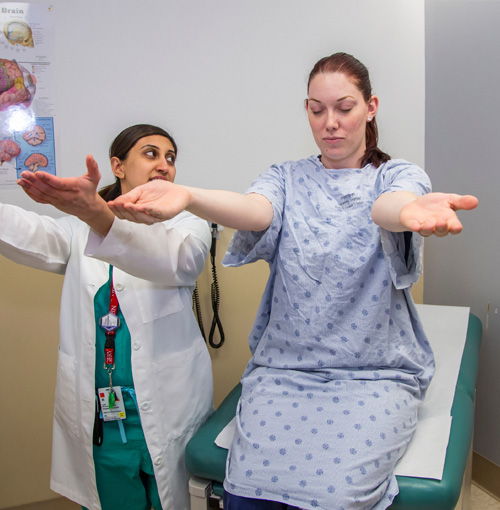What if you show signs of stroke, but your test results come back normal? How would you react if you’re having what seems like seizures, but you don’t have epilepsy?
Unfortunately, this scenario is all too common, and patients are often dismissed by provider after provider without answers. Worse, many are told that their symptoms are “all in their head” or just anxiety or depression.
The symptoms are real and significant. While the condition is invisible, it is no longer a diagnosis of exclusion. We can give it a name: Functional neurological disorders (FNDs).
While FNDs are the second most common outpatient neurological complaint in the U.S., most people don’t know what causes them or even what to call them. They mimic neurological conditions but are more nuanced to diagnose, with no known biomarkers, and the results of diagnostic tests such as EEG, EMG or MRI come back normal.
In a 2022 paper, I described the symptoms as mind-body dyssynergia, a framework for treatment in which the mind does not feel like it should in the body, and typically is an indicator that something is awry in both.
University of New Mexico Health Sciences Center offers a dedicated clinic to diagnose and treat functional neurological disorders. We listen to patients, validate their concerns and help them build effective, lasting treatment plans to manage symptoms and get back to the fulfilling lives they deserve.
Imagine Your Brain Is a Computer
In the past, doctors and scientists called unexplained symptoms like weakness, numbness or tremors “conversion disorder.” They believed FND symptoms were caused by stress or trauma so great that the mind reacted by “converting” that trauma into neurologic symptoms.
The problem with this theory is that it assumes there has been a causative trauma, which is only the case in about 30% of people with this type of disorder.
So what about the other 70%?
We’ve learned that FNDs are nerve function problems, not nerve structure problems, and they don't follow the rules of neuroanatomy. Instead, we can envision what’s going on in the brains of people with functional neurological disorders by thinking of the brain as a computer.
Computers have two types of memory. One stores information (ROM) and another lets the computer run many programs at once (RAM). Our brains work in a similar way—they can store a certain amount of memories like ROM, and they can also process a certain amount of thoughts and actions at once like RAM.
Functional neurological disorders are a problem with our RAM. When we have too many programs running at once, functioning can go awry. Everyday processes like talking, moving, and feeling stop working correctly because neural resources are used up by pain and stress.
A New Way to Diagnose Functional Neurological Disorders
Doctors used to diagnose these conditions by exclusion, or ruling out other diseases. The thought process was that if every available test returned normal results, a diagnosis of an FND could be made.
Now we know that’s not correct. FNDs should be diagnosed by inclusion—identifying a pattern that is inconsistent with how the mind and body are supposed to work.
For example, I diagnosed a patient who could not lift her left foot off the ground from a standing position. But she could lift her right foot, stand on her left leg only, and even dip down. That’s an example of inclusion: identifying a pattern that doesn’t follow the rules of neuroanatomy. We didn’t have to order time-consuming, expensive tests to exclude other disorders—the positive result of a bedside test established the diagnosis.
Functional neurological disorders can show up in countless ways. That’s because everything in neurology can be mimicked by an FND. Here are a few of the most common:
- Unexplainable weakness
- Walking or gait dysfunction
- Tremor that doesn't fit patterns known for tremor
- Typical stroke symptoms
- Shaking that looks like a seizure
Migraine Diagnosis as a Template
Migraines are almost always invisible on neuroimaging. To diagnose a migraine, we rely on clinical patterns—and the same approach can be used for functional neurological disorders.
Diagnosing FNDs in this way allows the patient to understand why the inconsistencies in their physical exam don’t fit with the current knowledge of nervous system dysfunction from structural damage. Diagnosing by inclusion also validates the patient’s condition by giving it a name, instead of just giving them a list of disorders they don’t have.
The importance of getting the diagnosis right can’t be overstated. In fact, we’ve seen patients at the UNM HSC Department of Neurology who recover when the diagnostic ambiguity is removed, simply because they are empowered to understand what's happening to their mind and body.
The sooner a functional neurological disorder is identified and treated, the more likely it is to resolve. After diagnosis, the clinician and patient can explore further to find the “why” behind the disorder and make a treatment plan. The reasons why the body and mind stop working in harmony do not have to be psychological. For example, pain or illness could be the culprit.
Treatment should focus first on managing symptoms and addressing the most significant clinical features. Some patients benefit from inpatient rehabilitation, and others get help from a psychologist. Interventions don’t have to be purely physical or purely psychological and should be personalized to each patient.
As the only academic medical center in New Mexico, we welcome patients with new or worsening symptoms along with those who have been told for years that there is nothing to be done for their condition.
There is growing support at UNM HSC for dedicating more resources to functional neurological disorders, and it is our goal to create a clinic focused on these invisible conditions. In the coming years, we hope to launch a center focused on diagnosing and treating these challenging conditions so more people can find relief.

